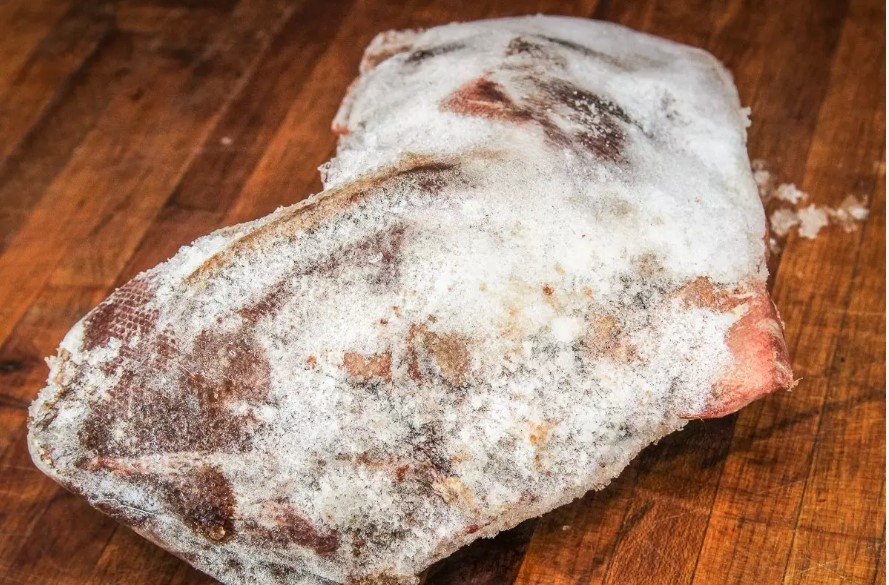Deer meat can last up to 12 months in the freezer if properly packaged. Ensure the temperature remains at or below 0°F.

Deer meat, also known as venison, is a popular game meat cherished for its lean texture and rich flavor. Freezing venison is an excellent way to preserve its quality and extend its shelf life. Proper packaging, such as vacuum sealing or using freezer paper, helps prevent freezer burn and maintain the meat’s freshness.
Consistently keeping the freezer temperature at 0°F or lower is crucial. This ensures that the deer meat remains safe to eat and retains its taste and nutritional value. Storing deer meat correctly allows hunters and consumers to enjoy it long after the hunting season has ended.

Shelf Life Of Deer Meat
Deer meat, also known as venison, is a popular choice among hunters. Its shelf life depends on various factors. Proper storage ensures you enjoy fresh meat for longer periods.
Factors Affecting Longevity
- Freezer Temperature: The ideal temperature is 0°F (-18°C) or lower.
- Packaging: Use vacuum-sealed bags or airtight containers.
- Quality at Freezing: Freshness at the time of freezing impacts longevity.
- Defrosting Method: Slow defrosting in the refrigerator is best.
Optimal Storage Conditions
For the best results, follow these storage tips:
- Wrap the meat tightly in plastic wrap.
- Place the wrapped meat in a vacuum-sealed bag.
- Label each package with the date.
- Store in the coldest part of your freezer.
| Storage Method | Recommended Duration |
|---|---|
| Vacuum-Sealed | 1-2 years |
| Airtight Containers | 6-12 months |
| Plastic Wrap & Freezer Paper | 6-9 months |
Remember, proper handling of deer meat ensures safety and quality. Always check for signs of spoilage before consumption.
Preparing Deer Meat For Freezing
Freezing deer meat preserves its quality and taste. Proper preparation ensures the meat stays fresh and flavorful. Follow these steps for the best results.
Proper Cleaning Techniques
First, clean the deer meat thoroughly. Remove any dirt, hair, or debris. Use cold water to rinse the meat. This helps in removing any surface contaminants.
Next, pat the meat dry with a clean cloth. Moisture can cause freezer burn. Dry meat freezes better and lasts longer.
Check for any bruised or damaged areas. Cut these parts away. Only freeze high-quality meat. This ensures the best taste and texture.
Best Practices For Cutting
Cut the deer meat into portions. Smaller pieces freeze faster and more evenly. Use a sharp knife for clean cuts. This helps in preserving the meat’s structure.
Label each package with the date. This helps you keep track of storage time. Use vacuum-sealed bags for the best results. These bags remove air, preventing freezer burn.
Consider using different bags for different cuts. For example:
- Steaks
- Roasts
- Ground meat
This makes it easier to find what you need later. Store the meat in the coldest part of the freezer. This ensures it stays at a consistent temperature.
| Type of Cut | Best Storage Time |
|---|---|
| Steaks | 6-12 months |
| Roasts | 6-12 months |
| Ground meat | 3-4 months |
Following these steps ensures your deer meat lasts longer in the freezer. Enjoy fresh and delicious venison year-round.
Packaging Deer Meat
Properly packaging deer meat is essential for preserving its quality and taste. The right packaging can make the difference between delicious, fresh meat and freezer-burned disappointment. Here, we explore the best methods for packaging deer meat for long-term storage in the freezer.
Choosing The Right Materials
Choosing the right materials is crucial. Using improper materials can lead to freezer burn. Here are some ideal materials:
- Plastic Wrap: Use a heavy-duty plastic wrap to cover the meat tightly.
- Freezer Paper: Freezer paper has a plastic coating that helps seal in moisture.
- Aluminum Foil: Aluminum foil is excellent for an extra layer of protection.
- Freezer Bags: High-quality freezer bags can prevent air from reaching the meat.
Use a combination of these materials for the best results. Double-wrapping meat can extend its freezer life.
Vacuum Sealing Benefits
Vacuum sealing is one of the best methods for packaging deer meat. It removes all air, which helps prevent freezer burn.
| BenefitDescriptionExtended Shelf LifeVacuum-sealed meat can last up to two years in the freezer. | |
|---|---|
| Preserves Flavor | Sealing in the meat’s natural juices keeps it flavorful. |
| Space Efficient | Vacuum-sealed packages take up less space in the freezer. |
Invest in a good vacuum sealer to protect your deer meat. This method ensures the meat remains fresh and tasty for longer periods.
Labeling And Dating
Proper labeling and dating are crucial for ensuring the quality of your frozen deer meat. It helps you keep track of the storage time and prevents spoilage.
Importance Of Accurate Labeling
Accurate labeling ensures you know what type of meat you have. It also helps identify the cut and processing date. This practice prevents confusion and waste.
When labeling, include the following:
- Type of meat (e.g., venison steak)
- Processing date
- Weight or quantity
Proper labels help in planning meals and managing your inventory efficiently.
Effective Dating Methods
Dating methods are essential for tracking how long deer meat has been stored. Use a clear and visible format. Write the date in the format MM/DD/YYYY. This format is easy to read and understand.
Consider using waterproof markers for labeling. This ensures the information remains legible even if it gets wet.
Alternatively, use printed labels. These can be more durable and easier to read.
| Labeling Method | Advantages |
|---|---|
| Waterproof Marker | Quick and easy to use |
| Printed Labels | More durable and legible |
Whichever method you choose, ensure it’s clear and easy to read. This practice helps maintain the quality and safety of your deer meat.

Freezing Methods
Deer meat can last long in the freezer if frozen correctly. Different freezing methods impact how long the meat stays fresh. This section discusses two common freezing methods for deer meat.
Flash Freezing Vs. Standard Freezing
Flash freezing involves freezing the meat very quickly at extremely low temperatures. This method is often used in commercial settings. The meat is placed on a metal sheet and exposed to temperatures below -30°F.
Standard freezing is what most people use at home. The meat is placed in a freezer set to 0°F. It takes longer to freeze compared to flash freezing.
Pros And Cons Of Each Method
| Method | Pros | Cons |
|---|---|---|
| Flash Freezing |
|
|
| Standard Freezing |
|
|
Thawing Deer Meat
Thawing deer meat correctly is crucial for maintaining its quality and safety. Improper thawing can lead to spoilage or bacterial growth. Here are some effective methods to safely thaw deer meat, ensuring it remains fresh and delicious.
Safe Thawing Techniques
Using safe thawing techniques is important. Three main methods are recommended:
- Refrigerator Thawing: Place the meat in the fridge. Allow it to thaw slowly. This method takes 24 hours for every five pounds of meat.
- Cold Water Thawing: Submerge the meat in cold water. Change the water every 30 minutes. This method takes about 30 minutes per pound.
- Microwave Thawing: Use the microwave’s defrost setting. Thaw the meat evenly. Cook immediately after thawing.
Avoiding Common Mistakes
Avoiding common mistakes ensures your deer meat remains safe to eat. Here are some pitfalls to avoid:
- Thawing at Room Temperature: Never thaw meat on the counter. This can lead to bacterial growth.
- Using Hot Water: Hot water can cause the outer layer to cook. This increases the risk of bacteria.
- Re-Freezing Thawed Meat: Do not refreeze meat that has been thawed. This can affect the texture and safety.
By following these guidelines, you can enjoy your deer meat safely and deliciously.
Signs Of Spoilage
Knowing the signs of spoilage is crucial for your safety. Properly stored deer meat can last a long time in the freezer. But, sometimes, spoilage happens. Here are the key indicators that your deer meat has gone bad.
Visual Indicators
Check for discoloration. Fresh deer meat should have a deep red color. It may be spoiled if it turns brown, gray, or green. Ice crystals are another sign. Small ice crystals are normal. But large ice crystals could mean the meat has been thawed and refrozen.
Look for mold. Mold can appear as white, green, or black spots. If you see mold, discard the meat immediately.
Smell And Texture Changes
The smell test is vital. Fresh deer meat should not have a strong odor. Spoiled meat will have a sour or rotten smell. If you notice this smell, it is best to discard the meat.
Check the texture. Fresh meat should be firm to the touch. Spoiled meat will feel slimy or sticky. This is a clear sign of spoilage. If the texture feels off, do not consume the meat.
| Signs | Indicator |
|---|---|
| Color | Brown, gray, or green |
| Ice Crystals | Large ice crystals |
| Mold | White, green, or black spots |
| Smell | Sour or rotten |
| Texture | Slimy or sticky |
Tips From Experts
Storing deer meat in the freezer is an art. Experts provide valuable advice to ensure your venison stays fresh and tasty for as long as possible. Below, we share insights from both hunters and chefs.
Advice From Hunters
Hunters know how to keep deer meat fresh. They follow specific steps to ensure quality. Here are their tips:
- Proper Cleaning: Clean the meat immediately after the kill.
- Quick Cooling: Cool the meat quickly to avoid bacteria growth.
- Vacuum Sealing: Seal the meat in vacuum bags to prevent freezer burn.
- Labeling: Label each package with the date of freezing.
Insights From Chefs
Chefs have unique methods to keep deer meat fresh. Their focus is on flavor and texture. Here are their insights:
- Cutting: Cut the meat into portions before freezing.
- Marinating: Marinate the meat before freezing to enhance flavor.
- Double Wrapping: Wrap the meat in plastic wrap, then foil.
- Freezer Temperature: Keep the freezer at 0°F or lower.
| Expert | Tip | Reason |
|---|---|---|
| Hunter | Quick Cooling | Prevents bacteria growth |
| Chef | Double Wrapping | Prevents freezer burn |
By following these expert tips, you can ensure your deer meat lasts long and tastes great. Happy cooking!
Frequently Asked Questions
Is 3-Year-Old Frozen Venison Still Good?
3-year-old frozen venison can still be good if properly stored at 0°F or below. Always check for freezer burn and off smells before consuming.
How Can You Tell If Deer Meat Is Spoiled?
Check for a sour or rancid smell. Look for discoloration or slimy texture. Inspect for mold or unusual spots.
How Long Can A Wild Game Last In The Freezer?
Wild game can last up to 12 months in the freezer if properly packaged. Ensure airtight wrapping to prevent freezer burn.
How Long Does Meat Really Last In The Freezer?
Meat lasts up to 12 months in the freezer if stored properly. Ground meat lasts 3-4 months. Always label and date your packages.
How Long Does Meat Really Last In The Freezer?
Meat lasts up to 12 months in the freezer if stored properly. Ground meat lasts 3-4 months. Always label and date your packages.
Conclusion
Properly stored, deer meat can last up to a year in the freezer. Ensure it’s wrapped tightly to prevent freezer burn. Labeling packages with dates helps keep track. Enjoy your venison dishes without worry. Careful storage guarantees fresh and delicious meals every time.
Keep these tips in mind for the best results.


GIPHY App Key not set. Please check settings